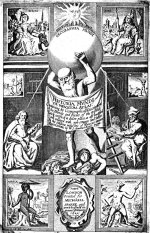Mercator's Maps
Today, let's meet the greatest mapmaker. The University of Houston's College of Engineering presents this series about the machines that make our civilization run, and the people whose ingenuity created them.
Gerardus Mercator was born Gerhard Kremer in the Netherlands in 1512. He Latinized his name when he entered the University.
A new visual world was opening like a flower around Mercator. Ships came back from the Americas with stories and drawings of a wondrous new land. All that information fed the Renaissance belief that you learn by looking closely and critically at the external world. In a hundred years that new visual sense would give birth to modern experimental science.
But now Mercator studied theology along with mathematics, astronomy, and geography. Then he began creating his own pictures -- his own maps -- of the world around him. When he was 25 he published a map of Palestine. Then he surveyed and mapped Flanders. In 1541 he made a globe of the world for the emperor.
He was also hip deep in reformation theology. When authorities rounded up suspected Lutherans, they took in Mercator. The ones who recanted were to be mercifully beheaded or maybe buried alive. The rest were to be burned at the stake. Mercator's parish priest interceded to save his life. After that Mercator shut up about religion and took work as a cosmographer in Germany.
There he mapped Europe and Britain. But larger maps were a problem. For years mapmakers had tried to figure out how to draw a flat map of our spherical planet. The best they'd managed had all the grace of a flattened orange peel.
Mercator solved that by making the lines of longitude run straight up and down. He stretched the map more and more toward each pole. He published this remarkable map in 1569.
So what if Greenland did look bigger than South America! It was simple, clear, and wonderfully useful to sailors who had to keep track of longitude. In the last few years we've replaced Mercator's projection with even more complex orange peels. But no orange peel can match Mercator's projection for simple clarity.
If any one thing marked the Renaissance, it was a new conviction that we could know by seeing. It was a visual age, and Mercator was acutely aware that the quality of his pictures was crucial. He was a superb artist in the new medium of copperplate engraving. He devoted one whole book to questions of calligraphy. It was a manual on how to label maps with Italic lettering.
We bandy the term Renaissance Man without asking what it really means. Mercator's life tells us. As a theologian, he tried to give us a new way to see the face of God. When that failed, he turned right about and gave us the technical means for seeing Earth whole. And in that he acted out another Renaissance belief -- that all learning, sacred or profane, leads to God.
I'm John Lienhard, at the University of Houston, where we're interested in the way inventive minds work.
(Theme music)
Wilford, J.N., The Mapmakers. New York: Vintage Books, 1982. (See especially Chapters 5 and 6.)
Boorstin, D., The Discoverers.New York: Random House, 1983. (See several scattered references to Mercator.)
Osley, A.S., Mercator: A monograph on the lettering of maps, etc. in the 16th century Netherlands with a facsimile and translation of his treatise on the italic hand and a translation of Ghim's VITA MERCATORIS. New York: Watson-Guptill Publications, 1969.
Mercator, G., Gerard Mercator's Map of the world (1569) in the form of an atlas in the Maritime Museum "Prins Hendrik" at Rotterdam; reproduced on the scale of the original and issued by the Maritiem Museum "Prins Hendrik" and the editors of Image mundi, Rotterdam: 1961.
Mercator, G., Historia mundi : or, Mercator's atlas; containing his Cosmographical description of the fabricke and figure of the world. Lately rectified in divers places, as also beautified and enlarged with new mappes and tables; by the studious industry of Ivdocvs Hondy (Tr. Wye Saltonstall), London: Printed by T. Cotes for Michael Sparke and Samuel Cartwright, 1635 [i.e., 1637].
See also Enclopaedia Britannica and Dictionary of Scientific Biography entries under Mercator.
For more on Mercator see Episode 889 on Abraham Ortelius. Although Ortelius made the first Atlas (or world map in book form), Mercator coined the term Atlas in the engraved title page of his Atlas. That title page is shown (courtesy of Special Collections, UH Library) in the thumbnail below. Click on the thumbnail for a full-size image.
